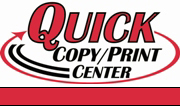|
||
|
|
|
Artwork File Types
We only accept High Resolution PDF's (Portable Document Format)
A free version is available on line at:
Providing a High Resolution PDF - CMYK
We have found that the most stable high resolution PDFs are produced from postscript files that are distilled with Acrobat Distiller's "PDF/X-1a" Job Option settings.
NOTE: the "PDF/X-1a" Job Option DOES NOT convert PMS spot colors to CMYK process.
Please consider these tips when producing a high resolution PDF:
Providing a High Resolution PDF - Spot Color
If you are creating a spot color job, use the same settings as above except do not convert your spot colors to process.
Spot colors are represented in most color pallets with an icon that looks like a circle within a square. Export the PDF as composite and our RIP should take care of the rest.
File Preparation Guidelines
Please review the following guidelines prior to sending digital files for best results for file transfer, set-up, and printing.
File Guidelines To ensure your files travel safely across the Internet, please compress your files before transfer with a file compression utility such as WinZip (Windows), PKZip (Windows), DropStuff (Macintosh), or ZipIt (Macintosh).
Bleed Please allow for 1/8" of bleed beyond the trim size of your document or panel. This will prevent the appearance of a white gap on the edge of your document if the cutter doesn't line up perfectly with each piece.
All critical copy must be at least 1/16 inch from the final trim edge to avoid the possibility of being trimmed off.
For Marks, we only use Crop Marks, default type, .25pt weight, offset .125". The offset part is important, I think it defaults to something smaller which means the crop marks are coming into the bleed, which is technically reducing the effectiveness of the bleed. For bleed and slug, the bleed should be .125" all the way around. Slug doesn't really matter, but internally we prefer that it be included and that the documents be set up with .5" slugs.
Minimum sizes Type: We recommend using no smaller than 4 point text for solid type. If font will be reversed from process, or built from process use fonts of size 8 points or larger for offset printing to guarantee readability. For best results limit the use of reverse type to block, gothic and sans serif type styles. Lines: Solid line rules should be .25 point thickness or greater. Rules built from process or rules reversed out of process should be 1 point. Smaller rules may disappear.
Colors In digital files, colors must be created and assigned in the manner in which they will print. Four-color process items should be set to use CMYK colors. If your project will use a spot color, designate it as such. If you use a spot color in the layout program, the usage of the color in an illustration program should reference the color with the exact name. (Example: Pantone 186 CV is not the same as Pantone 186 CVU.)
Rich black should be used to avoid a washed out appearance when graphics, boxes, or backgrounds are to print black. Use the values of 100% black, 30% cyan, 30% magenta, and 30% yellow to create rich black.
JPEG / JPG Supported by photographs around the world for its good image quality and compression. JPEG is expected to become the international standard for encoding digitized photographs. JPEG's greatest difference from all other file formats is that it uses Lossy compression. - thus you loose some image quality. Therefore always edit the original picture before saving it in the JPEG format. If you start with a JPEG file that needs edits, save it as an EPS or TIF file. This way, additional information will not get lost and the quality of the original JPEG image will be maintained. Convert your JPEG to a PDF before sending to us.
Please contact a Customer Service Representative with any questions. 1-864- 859-0048 |
Website Development by
Practical Business Systems
| Home Page | About Us | Contact Us | Terms of Use | Bookmark Us | Privacy Policy |
